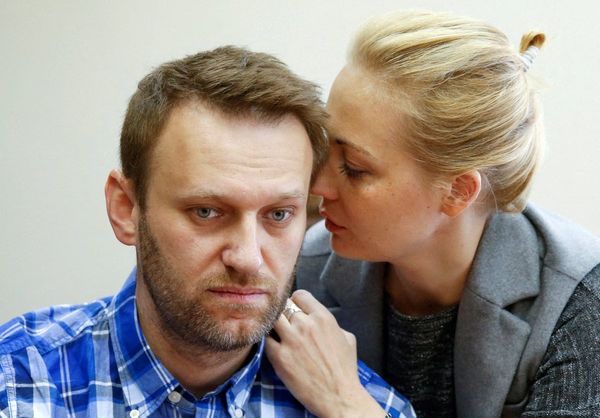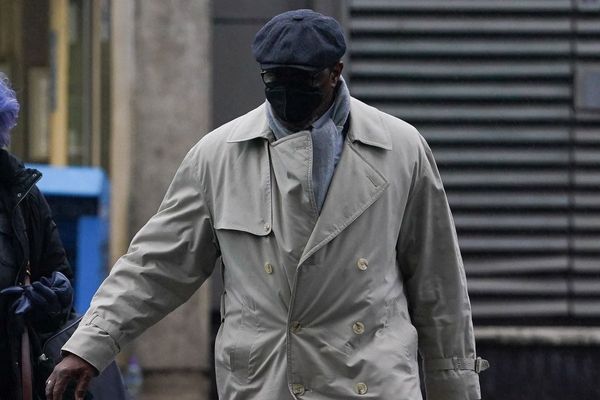
The gravestone in Helensburgh cemetery is in loving memory of someone, but it’s hard to tell exactly who. Exposure to 92 years of Scottish weather has rendered it grimy and grubby, but two small streaks of white at the bottom corner catch Ryan Nott’s attention on a rainy day in May. And so, the next day, the 31-year-old student accommodation manager comes back with a car boot full of equipment. He wears long sleeves to cover his arms and black rubber gloves. As the cemetery echoes to the cheers and chants of football fans watching a match on TV in the nearby flats, Nott starts to spray. The gravestone slowly begins to sizzle as the hydrochloric acid he’s splashed on the memorial stone creates a noisy, bubbling fizz. A grey smoke curls up towards the sky and as he scrubs the memorial with a steel brush, a light sweat beads his brow.
The stone features four intricately carved roses and each one is speckled with green moss and white lichen splodges. Nott takes out another brush, not unlike a children’s paintbrush, and works the acid into the petals. Quickly – so quickly that it almost seems like a magic trick – it becomes apparent that the headstone is made of white marble. Gorgeous, glistening, gleaming white marble on which the names of three long-departed sisters appear.
This is the 23rd gravestone that Nott has cleaned in this cemetery in the past year. Genealogy has been a hobby of his since he was 12, when a teacher sparked his interest by asking the class to make a family tree. In the small coastal town where the cemetery sits, Nott has become the go-to guy for ancestry research. “In the past 10 years, I’ve gone from building 10 family trees to 250, just from people saying, ‘Oh, can you do mine’,” he tells me.
But he didn’t begin grave cleaning until he got coronavirus. “I had Covid up until Christmas Eve and in that period I spent a lot of time on social media,” Nott explains. There, he discovered that grave cleaning is having its moment. On TikTok, the hashtag #gravetok has more than 750m views. Alicia Williams, a 42-year-old from Virginia, has 2.7m followers on her account, @ladytaphos, where she describes herself as “TikTok’s OG [original] grave cleaning lady.”
“It’s good for my soul,” says Williams, who began cleaning graves in 2018 while going through a “nasty divorce”. She uploaded her first TikTok video in 2020, when “there was nothing to do”. Her videos quickly went viral and inspired copycats. “I think the pandemic was a big factor, because the one place that was never shut down was a cemetery,” she says. “I also think people were a little more face-to-face with their mortality.”
It’s fairly obvious why people watch #gravetok content – satisfying cleaning videos are the internet’s bread and butter – but why do people create it? It took Nott an hour and 40 minutes to clean the three sisters’ grave, during which he sweated, accidentally splashed acid on his wrist and coughed as acid vapours blew in his face. “It’s definitely hard work,” Nott says (at least his mum works at the local hardware shop, meaning he gets mates rates on his equipment).
“I wanted the locals to see what was happening in their cemetery,” he explains. Nott doesn’t TikTok his cleans – instead he puts videos on his Facebook page, Tales of a Tombstone, and shares them with the local community. One woman couldn’t find her great-grandparents’ grave until Nott cleaned it and she saw the video on Facebook entirely by chance. In the caption of each clean, Nott writes about the deceased, including the addresses where people were born before hospital births were common, “and then people write in the group that they live there now!”
For Williams, cleaning is therapeutic. “Sometimes I sob and curse everything around me, curse myself while I clean,” she says. “I’ve gone through so much in life, a lot of traumas, and it made me an incredibly reactive person, especially in the beginning. I felt like it was kind of a personal penance to make up for any bad thing I’ve put out in the world.”

For Nott, the history appeals most: “I would say it’s 60/40 for me, 60 being the research and 40 being the clean. I definitely wouldn’t do this if I couldn’t do the backstory.” The grave he was cleaning belongs to Annie, Agnes and Margaret McWatters, all born in the mid-19th century. “All three sisters were born in the same house in Glasgow and all three of them died in the same house in Helensburgh,” Nott explains.
None of the McWatters sisters married. Margaret, who died last – at 82 – spent 13 years in their home alone. Nott looked at the sisters’ birth and death certificates and even “walked through” their house, thanks to a video on an estate agent’s website. But questions remain. Why didn’t they marry? Did they ever fall in love? Nott found the sisters on the 1861, 1871 and 1881 censuses – but they were missing on 1891’s. “My dad says they must all have gone to Corfu for the week!”
Remarkably – because this is, after all, the internet – Nott has never received a single negative comment on any of his cleaning videos, “not even verging on slightly negative”. While we dig into nougat wafers in a local ice-cream parlour after the McWatters grave has been restored, the owner tells Nott that someone once tried to clean his shop sign without asking – he wasn’t pleased. Some things, he argues, are meant to look weathered and old.
It’s an ongoing debate on #gravetok – Williams has received messages saying stones should be “allowed to return to nature and disintegrate”. Nott isn’t necessarily convinced: “I know that it shows how old something is, but I think it’s impressive to keep something so old looking so good.”
The main bone of contention on #gravetok, however, is the tricky matter of permission. Nott ensures that the deceased have no living, local relatives before he cleans their graves, but he doesn’t have permission from any authorities to undertake his work. Out of respect, some gravetokers only clean their family graves. Others take requests.
Ryan van Emmenis is a 39-year-old exterior cleaner from Winsford who began restoring graves with his children during the first lockdown after locals began requesting his services. He has now cleaned more than 100 graves.
“People started to ask if they could pay me, but I didn’t feel right taking any money,” van Emmenis says – instead, he set up a JustGiving page to take donations for a local hospice. Nott also cleans on request. An old lady once walked past while he was scrubbing and asked him to clean her aunt and uncle’s grave – he did so there and then. He also earns nothing from his work, but his friend created a GoFundMe that raised £900, which he used for equipment as well as access to birth, marriage and death certificates.
So, how exactly do you clean a grave? Williams uses gentle products that work gradually, meaning before and after pics can be months in the making. “I say that if you wouldn’t use it to wash your, car don’t use it on a gravestone,” she says. (She also uses bamboo skewers to clean between the letters on a stone.) Nott uses faster chemicals and always gives each stone “a wobble” first to ensure it’s up to a good scrub. Sometimes, he meticulously colours over faded lead lettering with a black Sharpie, “because paint would just come off”. Nott doesn’t touch limestone graves for fear they’ll corrode. He listens to Classic FM as he cleans.
Is there a risk that #gravetok will inspire copycats that don’t know what they’re doing? Simone Nathan, a 30-year-old TV writer from New Zealand who began cleaning graves at the end of 2020, says gravetokers should put warnings on their videos about getting permission and using gentle products – she herself has 35,500 followers.
But copycats might be necessary. In recent years, council cuts have affected cemeteries, as has the pandemic. In July 2020, human bones were exposed in a crumbling Perthshire cemetery after the council reduced maintenance work during lockdown. This February, Bradford residents complained that the council were not spending enough to maintain Bowling cemetery, while in April, Paisley residents spoke out about potholes, dead leaves and fallen stones at Hawkhead cemetery. “It’s in a disgraceful state,” one local said.
Nathan, who is Jewish, hopes to join a chevra kadisha, a society that ensures proper burial and sometimes upkeeps cemeteries. Her cleaning has already connected her to the local community – after she kept running out of water for her pressure hose, she approached gallery and café owners near the cemetery who now happily refill her tank. Many grave cleaners also make connections online – Nott and Williams have been emailing since February. Williams says grave cleaners used to be “a much more niche group of people who were gatekeeping a lot of information”. Now it’s easier than ever to pursue the pastime.
Motivations, of course, vary. “It’s a respect thing more than anything,” says van Emmenis, who is also happy to “teach my children to look after their surroundings”. As they clean, van Emmenis and his children discuss the deceased. “I don’t want to sound too cheesy, but it sort of brings people back to life temporarily,” he says.
Meanwhile, Nathan is “not really a spiritual person, but I do find this is the closest I come to having a spiritual experience.” Still, she doesn’t like it when people fawn in the comment section and say things like, “You’re amazing! God is watching over you.” “It’s not that deep,” she says, “I’m probably getting more out of it, through how satisfying I find it. Mentally, I enjoy it so much. I’m not trying to do some big, ‘let’s save the world’ mission.”
Nott also isn’t trying to save the world, but he is at least trying to preserve it. He has become something of a local celebrity – he works at a friend’s “old man pub” on a Friday night and has been recognised by punters. A woman in a purple jacket walks past as he cleans and Nott says she describes herself as his “biggest fan”.
But it is the dead who Nott has connected with most, not the living. We tour the cemetery and he points out the graves he’s cleaned: a 19-year-old who died in a motorcycle accident and two matrons of the local hospital who “died together on the same day” after being hit by a car. “Every one I’ve done, I know information about them that not a lot of people would,” Nott says. “I really do respect the people here, and part of showing my respect is telling their story.”







